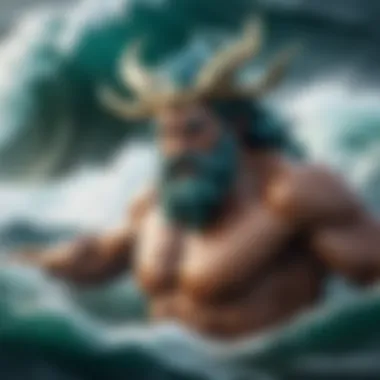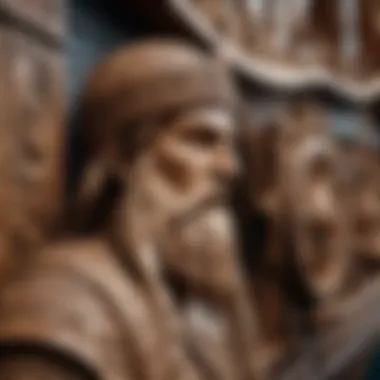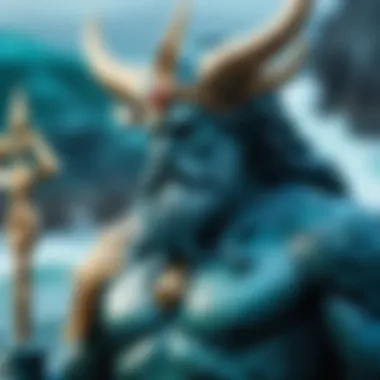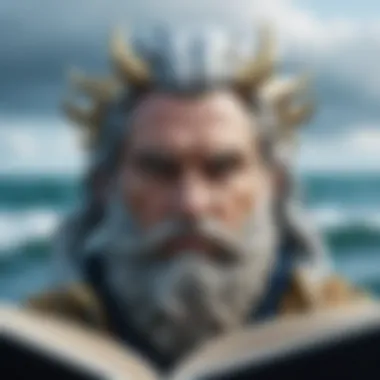Exploring the Sea God in Scandinavian Mythology


Intro
Scandinavian mythology is a treasure trove of rich narratives and profound symbols. At the center of this intriguing and often turbulent world, one can find a figure shrouded in mystery—the Sea God. Revered as a dominant force of nature, this deity personifies not just the vastness of the oceans but also the complexity of human interaction with the nautical realms. From ancient times, sea voyages have simultaneously sparked awe and fear among those who dared to traverse the waters. The Sea God stands as a representation of both the majesty and wrath of the seas, affecting the lives of mortals who relied upon the unpredictable element for sustenance and adventure.
In this exploration, we will discuss the origins of this complex figure in more detail, looking closely at different myths that have shaped his character over the ages. By drawing on multiple narratives and their societal impacts, we will also delve into how this deity has been depicted in art and literature, enriching our understanding of his significance in the Norse pantheon and beyond.
The Sea God: An Overview
Before diving into specifics, it is crucial to lay a foundation for understanding who the Sea God is within Scandinavian mythology. Often identified with Njord, he is not simply a figure of the ocean but also a deity of wealth, fertility, and wind. His interactions with other figures in Norse lore give him an added dimension, as he is not just an isolated entity but a part of a larger cosmic framework.
The myths associated with him are rich with symbolism, often illustrating themes of chaos and order, as well as the unpredictable nature of life itself. Moreover, Njord’s relationships with other gods and goddesses further enrich his narrative, reflecting the interconnectedness of divine and mortal realms.
Significance in Cultural Context
The cultural significance of the Sea God extends well beyond the mythological tales. Nautical practices of ancient Scandinavian societies were heavily influenced by a reverence for this deity. Fishermen and traders alike invoked his protection before venturing out to sea, believing that his favor was essential for a bountiful catch or safe passage.
"The waters are both a giver and taker of life; understanding Njord is understanding the very essence of our existence bound to the seas."
Thus, the Sea God embodies a duality that resonates with humanity's eternal struggle against nature's might. His representation in art—from ancient carvings to modern interpretations—serves as a testament to his lasting impact and the collective memory of those who sought his blessings.
In order to fully grasp the complexity of the Sea God, we will analyze several themes, including:
- Origins and historical background
- Key myths that define his character
- Interactions with other deities
- Artistic and literary representations
By examining these themes, we aim to unravel not only the tale of the Sea God himself but also the broader implications of his story in understanding Scandinavian culture and the universal human experience.
Foreword to Scandinavian Mythology
Scandinavian mythology is a window into the intricate beliefs and practices of the Norse people, shedding light on their understanding of the world and their place within it. This ancient tapestry of stories, deities, and cosmic interactions serves as a testament to the cultural richness that characterizes the region. It is not merely a collection of tales; it encapsulates the fears, hopes, and values of a society deeply connected to nature and the maritime environment.
The sea, a cornerstone of the Norse experience, reflects the reality of the harsh yet bountiful environment in which they lived. The emphasis on maritime life dictates several deities' roles, most notably that of the Sea God, who embodies the mysteries and power of the ocean. Therefore, understanding Scandinavian mythology offers insights beyond historical context; it allows one to grasp key themes such as creation, adventure, and the interplay of order and chaos—elements that resonate even today.
To look into the tenets of this mythology is to engage with the essence of what it meant to be part of a seafaring culture. Exploring the character of the Sea God reveals not just the mythology itself but also the cultural identity surrounding that identity, and how it has unfurled over centuries.
In this section, we will delve into the cultural context and historical significance of these myths, ultimately establishing a foundation for understanding the crucial roles these divine figures play in shaping narratives that span from ancient times to modern representations.
Cultural Context and Historical Significance
The roots of Scandinavian mythology are intricately embedded in the region’s history, shaped by climate, geography, and societal shifts. In the Viking Age, Norse mythology served not only as a religious framework but also as a narrative relevant to the socio-political landscape of the time. Seas were the lifeblood of Norse communities, their routes marked by the travels and conquests of explorers and traders. Through myths, tales of gods and heroes mirrored their lives, struggles, and triumphs.
Understanding these tales provides insight into how the Norse people perceived concepts like fate and the natural order. This mythology offered explanations for the unpredictable and often perilous conditions at sea, attributing divine characteristics to natural phenomena. The significance of these stories stretches beyond entertainment or moral teaching; they cement a shared identity among the Norse, creating bonds through common beliefs, rituals, and practices.
Key Themes and Figures in Norse Myth
Norse mythology is replete with themes of adventure, conflict, and the constant battle between order and chaos. Central to this rich world of stories is the pantheon of gods, each representing various aspects of existence and nature. Among them, the Sea God stands out, embodying the unfathomable depths of the ocean.
One can’t overlook the trials and tribulations faced by figures like Thor, who battled giants and monsters that threaten the realm of the gods and men alike. This clash represents the struggle between civilization and chaos—an ever-relevant portrayal of the human condition.
Furthermore, myths often interweave with elements of fate, symbolized by the Norns, who weave the threads of life, underscoring the notion that even gods are subject to destiny’s hand. As we continue to explore the complexities of Scandinavian mythology, the Sea God will emerge as a crucial figure within these narratives, encapsulating both the spirit of the sea and the broader themes of existence itself.
Defining the Sea God


The role of the Sea God in Scandinavian mythology is much more than a mere figure of folklore. He embodies the mysterious and often turbulent nature of the sea itself. To define him, one must explore his origins, his attributes, and how they relate to the larger narrative of Norse myth. This exploration is essential, as it lays the groundwork for understanding how the Sea God interacts with other deities and impacts the culture and beliefs of the Scandinavian people.
Origins and Etymology
Delving into the origins of the Sea God reveals a rich tapestry of linguistic and mythological threads. The Norse word for "sea" is "sær," which may have influenced the naming of figures associated with the ocean. While Ægir is a notable candidate synonymous with the sea, Njord is another critical figure, often referred to as the god of the sea and wealth. Understanding these names offers a glimpse into the cultures that revered these deities, showcasing how the sea was integral to their lives.
In many ways, the etymology of the Sea God’s names reflects the awe and reverence created by the oceans. Both Ægir and Njord signify not just water but the livelihood that flows from it—fishing, trade, and voyages across the vast, unpredictable waters. In this context, the deep connection between language and mythology becomes apparent.
Attributes and Symbols
The attributes and symbols associated with the Sea God paint a vivid picture of his character. He symbolizes not only the bounty and beauty of the sea but also its fury and unpredictability. Attribute rich, he is often depicted holding a horn or a cup, representing hospitality and feasting—key elements in Norse culture. Sea gods in many mythologies have a strong connection to storms, tides, and ships, and these components all play a significant role in his domain.
Furthermore, mythological stories frequently illustrate Ægir's interactions with other gods, where he hosts grand feasts, showcasing his nurturing side. Such gatherings are emblematic of community and sharing, crucial in a society heavily dependent on the sea.
"The Sea God isn’t just a figure; he is the vast waters of life and death, nourishing and at times terrifying."
Consider the symbolism of the wave, which can be calm one moment and ferocious the next. This dual nature is mirrored in the Sea God’s character. The net, often used in fishing, may signify prosperity, while ships embody exploration but also the risks of the open sea. Through these symbols, the Sea God represents not just the water but the essential ties between nature, mythology, and the human condition in ancient Scandinavia.
Mythological Stories Featuring the Sea God
Exploring the mythological stories featuring the Sea God is crucial in understanding his role and significance within Scandinavian mythology. These stories not only reflect the cultural values and beliefs of the Norse people but also illuminate the intricate relationships he maintains with other deities and the natural world. The Sea God serves as a bridge between the earthly realm and the deep, uncharted waters, embodying the dichotomy of creation and chaos that characterized the maritime experience of the Vikings.
The tales often highlight specific elements such as creation myths, which delve into the origins of the sea and its divine inhabitants. They provide insights into how ancient Scandinavians interpreted the natural world around them, valuing both its beauty and its potential for destruction. Furthermore, the narratives of adventures and challenges faced by the Sea God showcase his influence over sailors and their voyages, reinforcing the belief that he held sway over the forces of nature.
Ultimately, these narratives not only serve the purpose of entertaining but also function as moral and philosophical lessons, emphasizing the interconnectedness of humans, gods, and nature. By dissecting these stories, we can glean broader understandings of Norse cosmology and the profound respect embodied in their mythology toward the seas.
Creation Myths and the Sea
Creation myths involving the Sea God offer fascinating glimpses into the understanding of the cosmos by ancient Scandinavian societies. The sea was often seen as a primordial element that existed before the land. In these myths, it’s common to find depictions of the Sea God emerging from chaotic waters, representing the birth of order from chaos. One prominent example involves the tale of Aegir, a sea giant who is often invoked in the tales about the world's creation.
Legend has it that Aegir, alongside his wife Ran, would host grand feasts for the gods. Their home was a grand hall under the sea, filled with shimmering gold and glistening jewels that reflected their dominion over the ocean. The imagery used in these stories resonates deeply, offering a vivid portrayal of the relationship between the gods and the sea.
Moreover, the creation myths emphasize the sea's role as both a giver and taker of life. The rich resources of the ocean provided sustenance to the people, while the unpredictable nature of the sea could lead to perilous conditions, revealing how the Sea God can be both a protector and a menace. This duality reinforces the notion that respect and reverence toward the sea were critical in Norse culture.
Adventures and Challenges
The tales surrounding the adventures and challenges faced by the Sea God highlight the dynamic and often treacherous interplay between deities and the elemental forces of nature. These stories typically depict the Sea God as not just a passive entity but as an active participant in the struggles between chaos and harmony.
For instance, one notable adventure describes the journey of the gods across vast seas to retrieve stolen treasures. In the process, they encounter serpents and monstrous sea creatures, illustrating the constant battle against both physical obstacles and the malevolent forces that dwell in the deep.
Such adventures underscore the sea's unpredictability and the courage required to traverse its depths. The Sea God, with his ability to control the currents, becomes the vital ally for any seafarer. Fables of sailors imploring the Sea God before embarking on a journey reflect how integral these stories were in guiding the behaviors and beliefs of communities that relied on the sea for their livelihood.
In sum, the adventures and challenges faced by the Sea God unveil a tapestry of interwoven tales that reinforce the significance of this figure in Norse mythology. They capture the essence of journey, struggle, and the eternal quest for knowledge and power amidst the vastness of the unknown.
Relationships with Other Deities
Understanding the relationships between the Sea God and other deities in Norse mythology sheds light on the intricate dynamics of the pantheon. This section explores the significance of these interpersonal connections and their influence on the Sea God’s role within the mythological framework. The intertwining narratives among gods not only bolster their individual identities but also create a rich tapestry of stories that reflect ancient Scandinavian beliefs and values.
The Role of the Sea God in the Pantheon
The Sea God stands out in the Norse pantheon, holding sway over the waters and the creatures that dwell within them. His role is essential, as he maintains a balance among the various elements of nature, often acting as a mediator between earthly beings and the cosmic forces at play. More than just a deity of storms and waves, he is seen as a vital conduit for sailors and fishermen, representing both the bounty of the sea and its dangers.


He embodies complexity through relationships with other gods. For instance, his association with Njord, the god of winds and seafaring, highlights a shared dominion over oceanic matters, though Njord emphasizes wealth and abundance from fishing and trading. In contrast, the Sea God’s fierce temperament can be an embodiment of nature’s wrath, symbolizing storms and rough seas that can jeopardize maritime ventures.
Moreover, this deity is intricately linked to the cycle of life and death, similar to how bodies of water nourish as well as destroy. This connection adds depth to his role, as he illustrates the duality present in nature and spirituality in Norse beliefs.
Interactions with Thor and Odin
Examining how the Sea God interacts with formidable figures like Thor and Odin enriches our understanding of both his character and the mythos surrounding these deities. Thor, the thunder god, frequently seeks the favor of the Sea God when embarking on voyages, relying on this celestial entity for favorable weather conditions and safe passage over tumultuous waters.
In legends, Thor’s journeys often take him both to the shores and beneath the waves, where he seeks the approval of the Sea God. These encounters underscore the importance of collaboration amid potentially disastrous situations. After all, even the mightiest thunder god must show respect to the deity of the sea—a testament to the power that water holds in shaping fate.
On the other hand, Odin, the chief of the gods, represents wisdom and foresight, often contemplating the mysteries of the universe and its interconnected elements. His relationship with the Sea God can be seen in tales revolving around knowledge and the deep mysteries of the ocean. Odin's pursuit of knowledge extends even under the waves, further embedding the Sea God into the high stakes of divine interactions.
Through these relationships, the complexities of the Sea God are unveiled, showing him not just as a static entity but as an active participant in the dynamics of power play among gods.
"The nature of the Sea God encapsulates both tranquility and fury. His relationships with other deities are a reminder that harmony in mythology needs understanding of each other's essence."
In summary, the Sea God serves a multifaceted role within the Norse pantheon, his interactions fostered through a web of alliances and conflicts. This exploration fosters a deeper appreciation for how the ancient Norse viewed the world around them, seeing the divine as both powerful and interdependent.
Cultural Representations
The portrayal of the Sea God in various cultural expressions represents a critical exploration of how deeply rooted Norse mythology is within the fibers of Scandinavia’s cultural identity. This isn’t just about ancient stories; it reflects how these narratives have shaped societal values, morals, and, importantly, the respect for nature that tradition often embodies. Through art and literature, as well as modern adaptations, the Sea God’s journey from ancient myth to contemporary consciousness highlights his enduring significance in various aspects of life and understanding.
Art and Literature
Artistic representations of the Sea God often draw from iconic symbols—waves, ships, and storms—embedding a sense of nature’s ferocity and beauty into visual storytelling. Historically, Viking ships have carried artworks and carvings that celebrate marine life and the gods associated with the sea, showcasing an intricate connection between the sea and those who rely on it for their livelihood. The deep-set reverence for the ocean emerges in works like the tapestries of the Middle Ages, where images would depict gods battling sea monsters or taming treacherous waters.
In literature, the Sea God often symbolizes the unpredictable nature of life itself. Poetry from the sagas reveals him as a fierce protector and a chaotic force, reflecting a world where survival depended on understanding and respecting the whims of the ocean. Texts like Edda and Saga of the Skjoldungs vividly illustrate his attributes, inviting readers to interpret ancient wisdom through contemporary lenses.
Moreover, the variations of his character in poems often resonates, leading audiences to see their own struggles mirrored in myth. His duality—sometimes gentle, sometimes wrathful—mirrors the human experience, promoting introspection among readers.
For example, in one particular tale, he might be depicted calming a storm, showcasing his benevolence, while in another, extraordinary storms rage under his command, emphasizing man's vulnerability against nature.
"The Sea God embodies the tumultuous dance of existence; his stories are not merely past tales but are reflections of our struggle against nature's vastness."
Modern Adaptations in Film and Media
In recent times, the reimagining of the Sea God in film and media has triggered a renewed interest, accentuating not just ancient, but contemporary struggles with identity and environmental consciousness. Franchises like Marvel's Thor series have portrayed characters inspired by Norse mythology, linking them with modern narrative twists that resonate with audiences worldwide. This adaptation offers a bridge between ancient beliefs and modern heroism, making mythology more accessible to today’s viewers.
Documentaries and cinematic ventures also provide an engaging overview of Scandinavia’s maritime heritage, often revisiting tales of the Sea God through historical contexts. These films can illuminate how essential the sea was to Viking culture, shaping trade and conquest, while fostering a gripping narrative that explores humanity's relationship with the ocean.
As streaming platforms delve into mythological stories, new narratives are emerging that spotlight the Sea God, bringing fresh interpretations that challenge or reinforce traditional representations. Podcasts, vlogs, and even social media platforms are buzzing with discussions about these depictions, proving that the Sea God continues to stimulate interest and dialogue, connecting past with present.
By weaving these cultural representations, whether through art, literature, or media adaptations, the Sea God remains a vital cultural symbol. He embodies the struggles against nature, the intricate tapestry of maritime heritage, and the evolving narratives that contribute significantly to Northern European identity. In this realm, the myths are not static; they breathe and adapt, ensuring that the legacies of old forever resonate in new and engaging ways.
Comparative Analysis with Other Mythologies
In the study of the Sea God within Scandinavian mythology, it becomes particularly relevant to engage in a comparative analysis with sea deities from other cultures. This exploration not only highlights the unique characteristics and functions of the Scandinavian Sea God but also underscores the shared motifs and themes that permeate various mythological traditions. By dissecting how the Sea God is portrayed in context to figures such as Poseidon from Greek mythology or Neptune from Roman lore, we delve deeper into the nature of human experience as reflected through these ancient narratives.
Such comparisons are beneficial for multiple reasons. They offer insights not just into the properties of the sea god within a specific pantheon but also allow us to recognize the broader spectrum of themes related to the ocean—chaos, uncertainty, nourishment, and bounty—in cultures that have relied on the sea for survival. By drawing parallels, we can trace how societies have dealt with the mysteries of the sea and the unseen forces that govern it.
Sea Gods in Greek and Roman Mythology


When we turn our gaze to Greek and Roman mythology, we encounter the prominent figures of Poseidon and Neptune, respectively. Both gods share a fundamental role as the rulers of the oceans, embodying power and authority over the water, much like the Scandinavian Sea God. Poseidon, for instance, is often depicted with his trident, commanding storms and waves. His character encapsulates both the benevolent aspects of the sea—providing sustenance and beauty—as well as its wrathful nature, capable of bringing destruction.
In contrast, Neptune, while taking cues from Poseidon, brings his own flair to Roman mythology. He is celebrated in various festivals and often associated with fresh water, showing how different cultures can adopt and adapt mythological figures to suit their needs and beliefs. This divergence emphasizes that while the core characteristics of sea gods often overlap, their cultural representations can significantly vary.
- Key Similarities:
- Key Differences:
- Both Poseidon and Neptune embody the natural chaos and unpredictability of the ocean.
- They are typically depicted wielding tridents, signifying their control over maritime forces.
- Poseidon is more frequently associated with the concept of earth and land, having a penchant for creating new islands through his strikes.
- Neptune’s attributes often lean toward the artistic and serene aspects of water, reflecting Roman civilization's values and lifestyle.
Myths from Other Nordic Cultures
A broader look at other Nordic cultures reveals even more nuanced representations of sea gods. For example, in Finnish mythology, we encounter the figure known as Ahto, who is likewise a god of the sea. Ahto carries similarities to the Scandinavian Sea God when it comes to his dominion over marine life and the physical body of water itself. However, while the Scandinavian Sea God is often perceived as a stabilizing force amid chaos, Ahto has a more ambiguous reputation, navigating the thin line between hazards and bountiful harvests from the sea.
These depictions in Nordic cultures illustrate the region’s interaction with the sea, emphasizing not just reverence but also caution. The myths surrounding Ahto include stories where he assists sailors during storms yet poses challenges to those who disrespect his domain. This duality shows distinct cultural values placed on the sea and its deities, reflecting a complex relationship shaped by both fear and admiration.
Thus, the comparative analysis of the Sea God against figures from Greek and Roman mythology, as well as other Nordic traditions, enriches our understanding of how cultures globally interpret oceanic deities. It showcases diverse tales of power and humility, danger and sustenance, ultimately painting a richer picture of humanity’s longstanding bond with the sea.
The God of Seas in Contemporary Discourse
In modern times, the figure of the Sea God from Scandinavian mythology resonates through various facets of contemporary life, reflecting cultural heritage and shaping identities. The sea is vast and unpredictable, much like the stories that surround it. As we delve into this topic, we need to consider how the ancient narratives continue to adapt and influence present-day beliefs and practices. This examination uncovers specific cultural elements and traditions, which bridge the gap between past and present, and underscores the relevance of these myths in today's society.
Folklore and Traditions in Modern Scandinavia
Scandinavian folklore is rich with tales that have morphed over generations—stories that echo the challenges and mysteries of the sea. Villagers and urban dwellers alike recall legends of the Sea God, passed down as cautionary tales or as sources of inspiration. From the fishing communities along the coast to the urban jungles of Stockholm and Copenhagen, these anecdotes remind people of their connection to the sea.
Many Scandinavian festivals still celebrate maritime traditions, often incorporating elements of the Sea God into their rituals. For instance, Midsummer Eve honors the abundance of the harvest while acknowledging the sea's bounty, culminating in practices that pay homage to water and its deities. Boats may be adorned with flowers, and offerings are made, echoing the ancient rites intended to appease the Sea God and ensure safe travels.
"In the whispers of waves, the old tales breathe anew, keeping history alive in the hearts of the sailors.”
Additionally, local folk songs, storytelling events, and craft fairs often feature themes about maritime adventures and mythical creatures. These gatherings not only provide a sense of community but also serve as a reminder of the ongoing dialogue between ancient lore and present-day life.
Influence on Northern European Identity
The identity of Northern Europeans is intricately linked to the sea—its beauty, bounty, and peril. The God of Seas transcends mere myth to embody the character and struggles of these communities. Understanding the Sea God in contemporary discourse enables individuals to explore their cultural roots and foster a sense of belonging within a shared historical narrative.
For many locals, the Sea God represents resilience against natural forces and the bond between humanity and nature. Throughout art, literature, and even tourism, his significance emerges as a guide and protector. The stories impart rich lessons about teamwork, survival, and respect for the environment—values that are critical in today’s ever-changing world.
Moreover, the sea serves as a backdrop for discussions about environmental conservation. Contemporary representations of the Sea God are often tied to movements advocating for the protection of marine ecosystems. Icons of mythology and folklore are mobilized to sensitize communities about their impacts on nature and highlight the enduring connection human beings share with the oceans.
Finale
The examination of the Sea God within Scandinavian mythology unveils not just a figure to be worshipped, but a complex entity that reflects wider themes of life, nature, and the human condition. His significance stretches far beyond ancient seafaring communities, illustrating the deep interconnection between people and the ocean that sustains them.
Summary of Key Insights
Reflecting on the exploration of the Sea God leads us to several poignant insights:
- Cultural Legacy: The Sea God has permeated art, literature, and modern interpretations, solidifying his place in both historical context and contemporary thought. His presence in ancient stories teaches about the natural world and its unpredictable essence.
- Symbolism and Attributes: Not merely a god of the waves, he embodies chaos and order, power and tranquility, reinforcing the duality present in many aspects of Norse mythology. Artists and writers often invoke his imagery to symbolize conflict, journey, and resilience.
- Inter-god Relationships: The dynamic nature of his interactions with gods like Odin and Thor illustrates a pantheon filled with characters that resonate with human experiences, thereby making these myths powerful tools for understanding ancient cultures and beliefs.
Future Perspectives on Scandinavian Mythology
As we look ahead, the study of the Sea God and Scandinavian mythology as a whole faces exciting pathways for exploration:
- Integration with Modern Narratives: There is an ongoing resurgence of interest in Norse mythology in popular culture. Films, video games, and literature continue to reinterpret these ancient tales, breathing new life into the Sea God’s narrative and allowing it to resonate with younger generations.
- Research Opportunities: Scholars can delve deeper into regional variations of the Sea God’s myth across different Scandinavian cultures. Each community may hold its own interpretation, revealing richer, varied tapestries of understanding about maritime life.
- Relevance to Contemporary Issues: In an age grappling with climate change and environmental concerns, the Sea God’s tales and the importance of the sea can serve as potent reminders of humanity’s relationship with nature, urging a deeper respect and protective stewardship of the oceans.
"In every drop of water, there is a story of life; the Sea God represents the very essence of that narrative, where mystery and knowledge intermingle."
The Sea God stands as a timeless figure, bridging ancient beliefs and modern challenges, demonstrating that mythology remains a vital lens through which we can examine our present and future.



